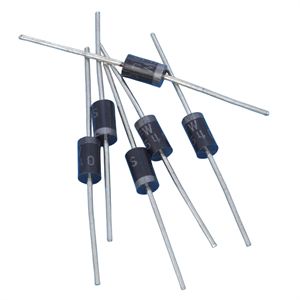Date:2024-09-19 Categories:Product knowledge Hits:468 From: Guangdong Youfeng Microelectronics Co., Ltd(YFW)
The diode categories we commonly use
● Rectifying diode
A semiconductor device that converts alternating current energy into direct current energy. Usually it contains a PN junction with two terminals, positive and negative. The most important characteristic of a diode is its unidirectional conductivity. In a circuit, current can only flow in from the positive pole of a diode and out from the negative pole.
● Fast recovery diode
Fast Recovery Diode (FRD) is a semiconductor diode with good switching characteristics and short reverse recovery time. It is mainly used in electronic circuits such as switching power supplies, PWM pulse width modulators, and frequency converters, as a high-frequency rectifier diode, freewheeling diode, or damping diode. The internal structure of a fast recovery diode is different from that of a regular PN junction diode. It belongs to the PIN junction type diode, which adds a base region I between P-type silicon material and N-type silicon material to form a PIN silicon wafer. Due to the thin base region and small reverse recovery charge, fast recovery diodes have a shorter reverse recovery time, lower forward voltage drop, and higher reverse breakdown voltage (withstand voltage value).
Ultra fast recovery diode
Super fast recovery diode (FRED) is a semiconductor diode with excellent switching characteristics and ultra short reverse recovery time. It is commonly used as a freewheeling, absorbing, clamping, isolating, output, and input rectifier for high-frequency inverter devices, allowing the switching devices to fully utilize their functions. Ultra fast recovery diode is an essential component for the high-frequency (above 20kHz) and solid-state development of electrical equipment
● High efficiency recovery diode
Schottky diode
The Schottky diode is named after its inventor Dr. Schottky, and SBD stands for Schottky Barrier Diode (SBD). SBD is not made using the PN junction principle formed by the contact between P-type semiconductor and N-type semiconductor, but using the metal semiconductor junction principle formed by the contact between metal and semiconductor. Therefore, SBD, also known as metal semiconductor (contact) diode or surface barrier diode, is a type of hot carrier diode.
Low voltage drop Schottky diode
● Switching diode
Switching diode is a type of semiconductor diode specially designed and manufactured for "on" and "off" in circuits. It takes less time for it to transition from conduction to cutoff or from cutoff to conduction compared to general diodes. Common series include 2AK, 2DK, etc., which are mainly used in electronic computers, pulse and switch circuits.
● Transient suppression diode
Transient Voltage Suppressor (TVS), abbreviated as TVS, is a high-performance protective device in the form of a diode. When the two poles of a TVS diode are subjected to a reverse transient high-energy impact, it can transform the high impedance between its two poles into low impedance at a speed of 10 ^ -12 seconds, absorbing surge power of up to several kilowatts, and clamping the voltage between the two poles at a predetermined value, effectively protecting precision components in electronic circuits from damage caused by various surge pulses.
● Zener diode
Zener diode, also known as Zener diode in English. A diode that functions as a voltage regulator by utilizing the reverse breakdown state of a pn junction, where the current can vary widely while the voltage remains relatively constant. [1] This diode is a semiconductor device that has high resistance until the critical reverse breakdown voltage. At this critical breakdown point, the reverse resistance decreases to a very small value, and in this low resistance region, the current increases while the voltage remains constant. Zener diodes are divided according to the breakdown voltage, and because of this characteristic, Zener diodes are mainly used as voltage regulators or voltage reference components. Zener diodes can be connected in series for use at higher voltages, and by connecting them in series, a higher stable voltage can be obtained. [2]
● High voltage diode
High voltage trigger diode is a type of silicon crystal diode that only conducts under high voltage. It is usually used in series with a large capacitor. When powered on, the capacitor slowly charges. When it reaches the trigger voltage of the high voltage trigger diode, it instantly conducts. Then, after starting a switch on the circuit, the capacitor discharges. If the voltage value is not enough to make it conduct, it returns to a high impedance state. When the capacitor charges to the set value, it triggers cyclically.
Silicon carbide diode
Schottky diode is a type of semiconductor device made by rectifying the contact barrier formed between metal and N-type semiconductor. The basic structure of Schottky diodes consists of heavily doped N-type 4H SiC wafers, 4H SiC epitaxial layers, Schottky contact layers, and ohmic contact layers.
ESD static TVS tube

Previous: Classification, Structure, and Principle of MOSFET
Next: What is the difference between Schottky diodes and transient suppression diodes?